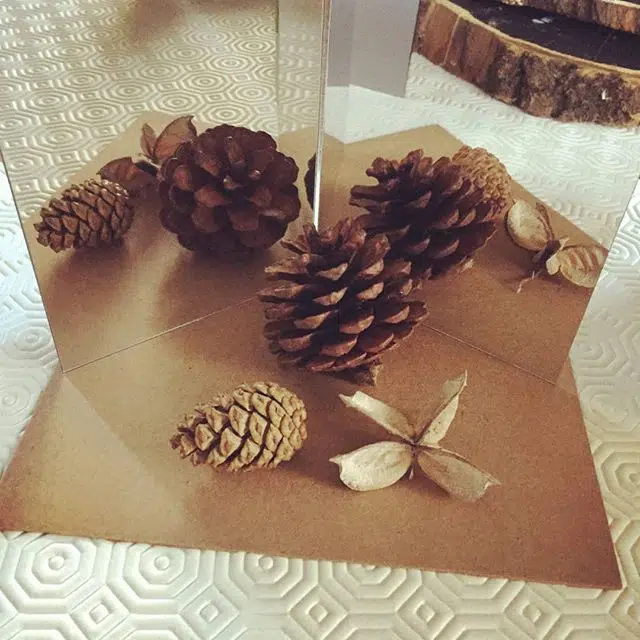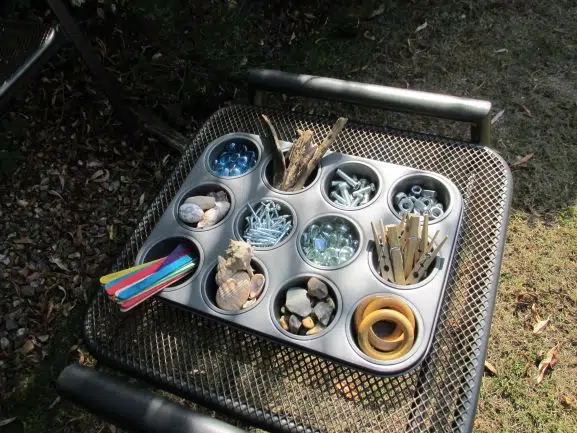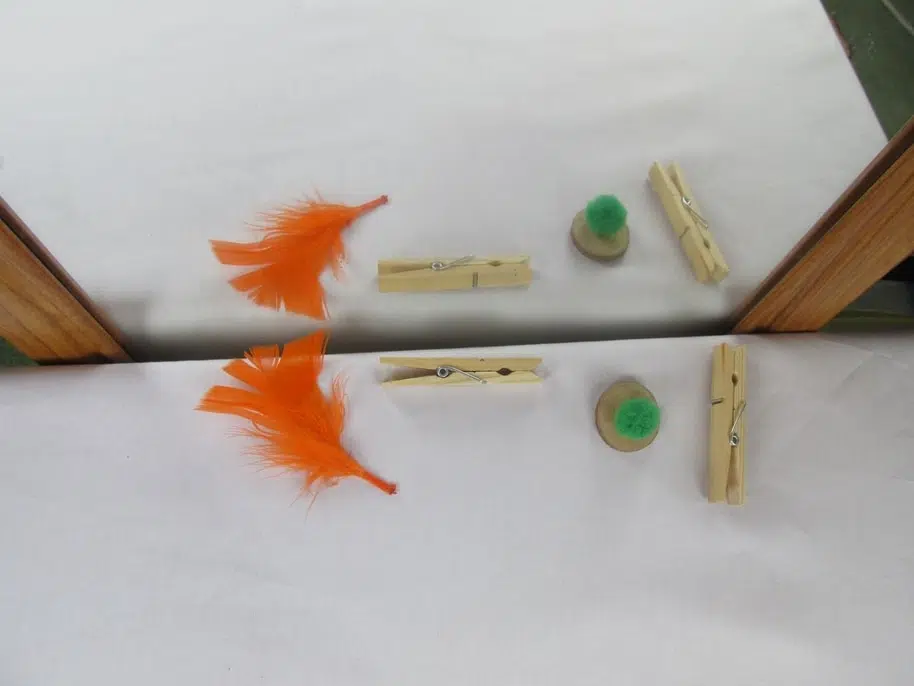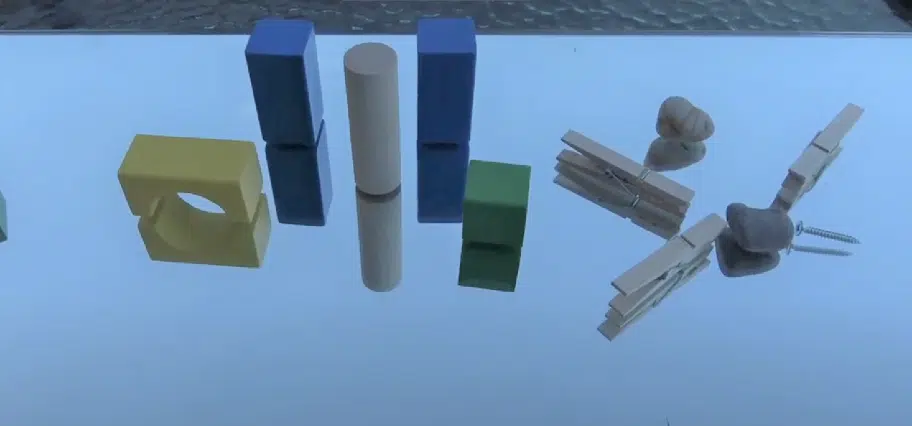Mirrors help young children develop an awareness of many things. They begin to understand reflection and symmetry. They also make children more aware of their own physical presence, and their movement.
Mirrors can be used alongside loose parts to add visual intrigue to provocations. You can create portraits or pictures on mirrors. Mirrors can be used in alcoves or in learning areas to enhance the experience.
I have taught children between the ages of 3-5 over the last 12 years, and these days I put mirrors everywhere!
In this article, I’ll walk you through my favorite 14 mirror activities for kids!

First, Tinker Trays + Safety Mirrors
One of the best ways to use mirrors is alongside ‘loose parts’. Loose parts are quite simply a selection of random objects that children can play with. They have no set intention. Some examples of loose parts could be pebbles, shells, clothespins, and pompoms.
I like to store loose parts in a ‘tinker tray’.
I usually use a compartmentalized baking tray or muffin tray.
Fill the sections with assorted loose parts. Here is a good example of a tinker tray:

I am going to be using a tinker tray like this for most of these mirror activities.
Another thing to bear in mind is to use safety mirrors. These are mirror that will not shatter if they are dropped, or have things dropped on them (which will happen!)
Right, now on with the ideas:
14 Mirror Activities For Kids
1.Mirror Books
These are some of the ultimate mirror activities using loose parts.
To create a mirror book, you simply need two thin mirrors. Tape the mirror together so they are roughly at a right angle.
Then stand the mirror book on a table-top, or shelf, or even on the floor or outside. The children use loose parts placed inside the mirror book.
The mirror book creates all sorts of spectacular reflections, multiplying the image many times. They can create pictures, patterns, or arrays. Whatever they create will be recreated numerous times across several planes of symmetry.
A brilliant introduction to symmetry, reflection, angles, and curiosity.

2. Symmetry Box
Mirrors are brilliant for exploring symmetry. Interested in symmetry ideas? Why not check out my article about the ultimate 10 symmetry activities for kids.
This is a simple setup. Get a box and stick a thin safety mirror to the side of it. Just taping it on will work fine.
Next to the standing mirror, the children can use loose parts from the tinker tray to create patterns or pictures. Whatever they create is reflected in the mirror. The next step is to create half an image that is then completed in the mirror. It could be half a face or half an insect.
The spirit of experimentation is one of the features of all these mirror provocations.

3. Mark-Making Lines Drawn On A Mirror
This is a simple activity that gets children beginning to think about simple mark-making lines and handwriting patterns.
On a large mirror, draw a range of mark-making lines. For example, a zigzag, a spiral, a wavy line, and a line that looks like a spring. If you use a pen suitable for writing on whiteboards, then it should wipe off fine later.
The children use smallish loose parts placed over the lines. Great for coordination, as well as creativity. They can make all sorts of patterns and sequences with loose parts.
4. Mirrors Inside A Shelf
If you look carefully, you will be able to find all sorts of little cozy nooks and mini-alcoves in your room that are fantastic for play provocations. These are really brought to life further by the use of mirrors.
Shelving units are fantastic for this. Many classrooms have small shelves designed for a single box. Put mirrors in the back, or the sides as well, and a few loose parts to hand, and you have a fantastic mini-world to explore creativity and storytelling.
Children can really get more entranced in their play – the element of visual awe and wonder really brings it to life.
5.Draw Round The Map
Loose parts are brilliant for creating maps, or alternatively obstacle courses. The idea of both is the same.
This is another activity that requires a big mirror on a table or the floor.
Have tinker trays of loose parts that you use to create the elements of the map. If it is a treasure map, for example, pegs could be the sharks in the sea, wood slices the stepping stones on the island, and so on. Just put lots of features on the map.
Then you get drywipe pens and draw around the features. Draw a path around them, or you could even draw map features on as well. Older children can attempt to write what some of the features are.
The same is true of the obstacle course idea. It is basically the same kind of thing – you scatter lots of loose parts all over the mirror. These are the obstacle course.
Now the idea is to draw a path around the obstacles. Remember, you can’t touch them! A fantastic simple mark-making activity that children really get the idea of and what to try out.
6. Messy Play On Mirrors With Loose Parts
This is fantastic, sensory fun, that can take the children on all sorts of routes of imagination and creativity.
You quite simply need a large mirror on a tabletop, and then something messy to go on it. Good things would be substances like shaving foam, porridge oats, or flour.
An assortment of loose parts thrown into the mix can be used in all sorts of ways.
You can draw lines and pictures in the substance. You can stack items.
You can swirl the substance around by using the loose parts.
Making disgusting witches potions is a great one for this. Use shaving foam with a bit of green paint swirled in, and random loose parts. This will really get the children talking and excited about what they are doing.
7.Creating Portraits
Creating portraits using picture frames is one of my favorite loose parts activities. Children just ‘get’ the idea, and they can create all sorts of characters.
A big mirror really adds to their engagement and gets them in the zone.
There are different ways of using the mirror. You can place it on the wall next to where they are working, so they see a reflection of their creation in the mirror.
Or you can place the mirror directly onto the table and they can put the picture frame on top. Then they can create their portrait character on top of the mirror.
They can create goodies, like a frog, a princess, and that kind of thing. Or it can be evil characters, like a witch, a dragon, or a wolf.
Great for experimentation, imagination, and developing a love of literacy.
8.Printing With Loose Parts On Mirrors
This one is wonderfully messy!
Have an assortment of loose parts that you mind throwing away at the end. Things like pompoms, feathers, and leaves are all good for this.
Also, have some different colors of paint.
Have a large mirror placed directly onto a tabletop. The idea is that the children dip the loose parts into the paint, and then print with them onto the mirror. You can create all sorts of patterns, arrays, and pictures.
Once again the mirror just adds an element of visual stimulation and interest.
9.Storytelling On Mirrors
Mirrors create a magical backdrop for all kinds of storytelling opportunities. Their beautiful reflective nature means they resemble a pond, or the sea, or just a kind of magical portal to another world.
Loose parts are fantastic for storytelling.
A feather can become a bird, a peg a crocodile.
Just let children explore the objects over the mirror. Some help with modeling will work well for some. The mirror becomes the setting of the story.
To enhance it further you can allow them to mark-make on the mirror, and draw on features of a setting, for example, trees, mountains, or an island. It may just look like a load of squiggles but it will be getting them thinking.
10.Making Repeating Patterns On Mirrors
Loose parts are wonderful for exploring patterns when children have reached this stage in their learning.
Have a large mirror on a table-top and tinker trays.
You can draw lines on the mirror for them to follow, or just leave the mirror blank and see what they come up with.
The simplest way to do this provocation is to limit them to just two types of loose parts in the tinker trays to start with. For example, you could have just pompoms and buttons.
The simplest pattern you can create would be pompom, button, pompom, button. If they get the idea of this, you can extend it to something more complicated – e.g. three colors in a sequence, or two of one of the items next to each other.
This loose parts activity takes more adult intervention and modeling to set up and get them started than some of the others.
11.Put Loose Parts On A Mirror
This is the simplest and most open-ended provocation out of all of these ideas.
You just have a large mirror on the table and a tinker tray of objects. That is it.
The children explore the many visual potentialities that they can create. Great for independence, and giving ownership of what they are doing.
Children will sometimes add context to what they are doing, sometimes not. Sometimes it will be a story or real-life scenario, sometimes not.

12.Painting Using Loose Parts On Mirrors
Loose parts are a fantastic thing to use in conjunction with fine motor. This is one way to do it.
Get some paint and a large tabletop mirror.
The idea now is to use loose parts dipped into the paint to create swirls and lines on the mirror. You can draw and paint all sorts of real images, or just experiment with line and color.
Some loose parts are great for fine motor.
For example, you can use pegs to pick up other loose parts and paint with them. For example, pick up a pompom or a feather with the peg, dip it in the paint, and away you go.
A really engaging fine motor experience.
13.Stacking Objects
Stacking is one of those natural instincts that many children like to experiment with repeatedly.
Stacking on a mirror is reasonably exciting because of the beautiful reflections it creates.
It is a fantastic way of exploring symmetry in a practical context.
Also, it is a starting point for visually understanding doubling. If you put one wooden block on a mirror, it becomes two. If you put two on, it becomes four.
Children may well not yet be able to speak about doubling in mathematical terms, but they will begin to develop an awareness that it exists. The more they can experience in real terms things like doubling, the easier those concepts will be to understand when they learn them in more specific terms later on.
You can stack all sorts of things – play dough balls, wood slices, corks, or bottle tops.
14.Constructing With Loose Parts Added
So many children enjoy construction, and adding loose parts into their building can take it to a new level.
Use something reasonably light for this, such as light small wooden blocks. Nothing that will shatter a mirror if it falls from a great height!
Children build using whatever it is. The loose parts can then become characters living in the buildings. Or vehicles, or animals, or whatever they like. It just adds a fantastic element of creativity, and thinking outside of the box.
Conclusion
Mirrors create a magical element to many learning experiences. They allow children to see themselves and also create beautiful visual illusions in their play.
Such a cheap and simple resource, good luck trying out some of these mirrors and loose parts ideas.
